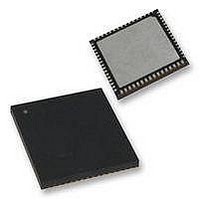PIC24FJ64GA106-E/MR Microchip Technology, PIC24FJ64GA106-E/MR Datasheet - Page 125

PIC24FJ64GA106-E/MR
Manufacturer Part Number
PIC24FJ64GA106-E/MR
Description
16-bit, 16 MIPS, 64KB Flash, 16Kb RAM, 84 I/O, NanoWatt 64 QFN 9x9x0.9mm TUBE
Manufacturer
Microchip Technology
Series
PIC® 24Fr
Datasheet
1.PIC24FJ128GA106-IPT.pdf
(330 pages)
Specifications of PIC24FJ64GA106-E/MR
Core Processor
PIC
Core Size
16-Bit
Speed
32MHz
Connectivity
I²C, IrDA, LIN, SPI, UART/USART
Peripherals
Brown-out Detect/Reset, LVD, POR, PWM, WDT
Number Of I /o
53
Program Memory Size
64KB (22K x 24)
Program Memory Type
FLASH
Ram Size
16K x 8
Voltage - Supply (vcc/vdd)
2 V ~ 3.6 V
Data Converters
A/D 16x10b
Oscillator Type
Internal
Operating Temperature
-40°C ~ 125°C
Package / Case
*
Processor Series
PIC24FJ256GA110
Core
PIC
Data Bus Width
16 bit
Data Ram Size
16 KB
Interface Type
UART, I2C, SPI
Maximum Clock Frequency
8 MHz
Number Of Timers
5
Operating Supply Voltage
3.6 V
Maximum Operating Temperature
- 40 C to + 85 C
Mounting Style
SMD/SMT
Lead Free Status / RoHS Status
Lead free / RoHS Compliant
Eeprom Size
-
Lead Free Status / Rohs Status
Details
- Current page: 125 of 330
- Download datasheet (3Mb)
9.0
The PIC24FJ256GA110 family of devices provides the
ability to manage power consumption by selectively
managing clocking to the CPU and the peripherals. In
general, a lower clock frequency and a reduction in the
number of circuits being clocked constitutes lower
consumed power. All PIC24F devices manage power
consumption in four different ways:
• Clock frequency
• Instruction-based Sleep and Idle modes
• Software controlled Doze mode
• Selective peripheral control in software
Combinations of these methods can be used to
selectively tailor an application’s power consumption,
while still maintaining critical application features, such
as timing-sensitive communications.
9.1
PIC24F devices allow for a wide range of clock
frequencies to be selected under application control. If
the system clock configuration is not locked, users can
choose low-power or high-precision oscillators by simply
changing the NOSC bits. The process of changing a
system clock during operation, as well as limitations to
the process, are discussed in more detail in
“Oscillator
9.2
PIC24F devices have two special power-saving modes
that are entered through the execution of a special
PWRSAV instruction. Sleep mode stops clock operation
and halts all code execution; Idle mode halts the CPU
and code execution, but allows peripheral modules to
continue operation. The assembly syntax of the
PWRSAV instruction is shown in
EXAMPLE 9-1:
2010 Microchip Technology Inc.
PWRSAV
PWRSAV
Note:
POWER-SAVING FEATURES
Clock Frequency and Clock
Switching
Instruction-Based Power-Saving
Modes
Section 10. “Power-Saving Features”
This data sheet summarizes the features of
this group of PIC24F devices. It is not
intended to be a comprehensive reference
source. For more information, refer to the
“PIC24F
(DS39698).
Configuration”.
#0
#1
Family
PWRSAV INSTRUCTION SYNTAX
Example
Reference
; Put the device into SLEEP mode
; Put the device into IDLE mode
9-1.
Section 8.0
Manual”,
PIC24FJ256GA110 FAMILY
Sleep and Idle modes can be exited as a result of an
enabled interrupt, WDT time-out or a device Reset.
When the device exits these modes, it is said to
“wake-up”.
9.2.1
Sleep mode has these features:
• The system clock source is shut down. If an
• The device current consumption will be reduced
• The Fail-Safe Clock Monitor does not operate
• The LPRC clock will continue to run in Sleep
• The WDT, if enabled, is automatically cleared
• Some device features or peripherals may
Additional power reductions can be achieved by
disabling the on-chip voltage regulator whenever Sleep
mode is invoked. This is done by clearing the PMSLP
bit (RCON<8>). Disabling the regulator adds an addi-
tional delay of about 190 s to the device wake-up
time. It is recommended that applications not using the
voltage regulator leave the PMSLP bit set. For addi-
tional details on the regulator and Sleep mode, see
Section 25.2.5 “Voltage Regulator Standby
The device will wake-up from Sleep mode on any of
these events:
• On any interrupt source that is individually
• On any form of device Reset
• On a WDT time-out
On wake-up from Sleep, the processor will restart with
the same clock source that was active when Sleep
mode was entered.
on-chip oscillator is used, it is turned off.
to a minimum provided that no I/O pin is sourcing
current.
during Sleep mode since the system clock source
is disabled.
mode if the WDT is enabled.
prior to entering Sleep mode.
continue to operate in Sleep mode. This includes
items such as the input change notification on the
I/O ports, or peripherals that use an external clock
input. Any peripheral that requires the system
clock source for its operation will be disabled in
Sleep mode.
enabled
SLEEP MODE
DS39905E-page 125
Mode”.
Related parts for PIC24FJ64GA106-E/MR
Image
Part Number
Description
Manufacturer
Datasheet
Request
R

Part Number:
Description:
Manufacturer:
Microchip Technology Inc.
Datasheet:

Part Number:
Description:
Manufacturer:
Microchip Technology Inc.
Datasheet:

Part Number:
Description:
Manufacturer:
Microchip Technology Inc.
Datasheet:

Part Number:
Description:
Manufacturer:
Microchip Technology Inc.
Datasheet:

Part Number:
Description:
Manufacturer:
Microchip Technology Inc.
Datasheet:

Part Number:
Description:
Manufacturer:
Microchip Technology Inc.
Datasheet:

Part Number:
Description:
Manufacturer:
Microchip Technology Inc.
Datasheet:

Part Number:
Description:
Manufacturer:
Microchip Technology Inc.
Datasheet:










